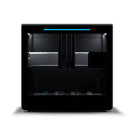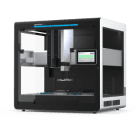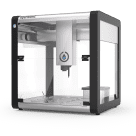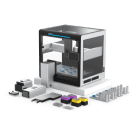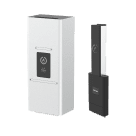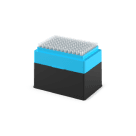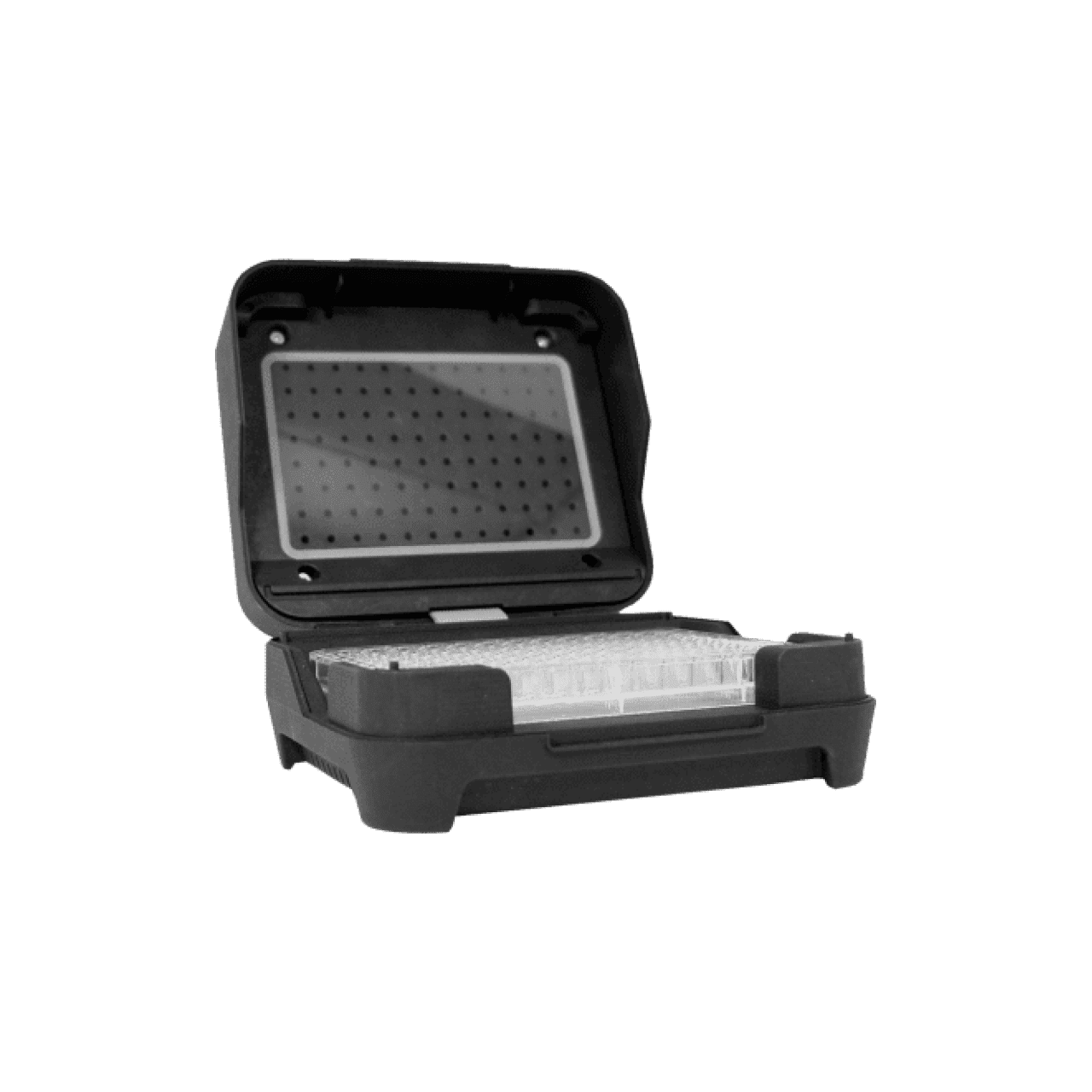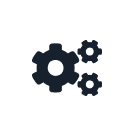Complex Liquid Handling Parameters¶
Complex commands accept a number of optional parameters that give you greater control over the exact steps they perform.
This page describes the accepted values and behavior of each parameter for different complex commands. The parameters are organized in the order that they first add a step. Some parameters, such as touch_tip, add multiple steps. See Order of Operations for more details on the sequence of steps performed by complex commands.
The API reference entries for InstrumentContext.transfer() and InstrumentContext.transfer_with_liquid_class() also list the available parameters and have more information on their implementation as keyword arguments.
Tip Handling¶
The new_tip parameter controls if and when complex commands pick up new tips from the pipette’s tip racks. There are five possible values:
Value |
Behavior |
|---|---|
|
|
|
Pick up and drop a tip for each set of aspirate and dispense steps. |
|
Do not pick up or drop tips at all. |
|
|
|
|
"once" is the default behavior for all complex commands.
Tip Handling Requirements¶
"once" and "always" require that the pipette has an associated tip rack, or the API will raise an error (because it doesn’t know where to pick up a tip from). If the pipette already has a tip attached, the API will also raise an error when it tries to pick up a tip.
pipette.pick_up_tip()
pipette.transfer(
volume=100,
source=plate["A1"],
dest=[plate["B1"], plate["B2"], plate["B3"]],
new_tip="never", # "once", "always", or None will error
)
Conversely, "never" requires that the pipette has picked up a tip, or the API will raise an error (because it will attempt to aspirate without a tip attached).
Avoiding Cross-Contamination¶
One reason to set new_tip="always" is to avoid cross-contamination between wells. However, you should always do a dry run of your protocol to test that the pipette is picking up and dropping tips in the way that your application requires.
transfer() and transfer_with_liquid_class() will pick up a new tip before every aspirate when new_tip="always". This includes when tip refilling requires multiple aspirations from a single source well.
distribute() and consolidate() only pick up one tip, even when new_tip="always". For example, this distribute() command returns to the source well a second time, because the amount to be distributed (400 µL total plus disposal volume) exceeds the pipette capacity (300 µL):
pipette.distribute(
volume=200,
source=plate["A1"],
dest=[plate["B1"], plate["B2"]],
new_tip="always",
)
But it does not pick up a new tip after dispensing into B1:
Picking up tip from A1 of tip rack on 3
Aspirating 220.0 uL from A1 of well plate on 2 at 92.86 uL/sec
Dispensing 200.0 uL into B1 of well plate on 2 at 92.86 uL/sec
Blowing out at A1 of Opentrons Fixed Trash on 12
Aspirating 220.0 uL from A1 of well plate on 2 at 92.86 uL/sec
Dispensing 200.0 uL into B2 of well plate on 2 at 92.86 uL/sec
Blowing out at A1 of Opentrons Fixed Trash on 12
Dropping tip into A1 of Opentrons Fixed Trash on 12
If this poses a contamination risk, you can work around it in a few ways:
Use
transfer()ortransfer_with_liquid_class()withnew_tip="always"instead.Set
well_bottom_clearancehigh enough that the tip doesn’t contact liquid in the destination well.Customize your liquid class to change dispense heights or add touch tip behavior.
Use building block commands instead of complex commands.
Mix Before¶
The mix_before parameter controls mixing in source wells before each aspiration. Its value must be a tuple with two numeric values. The first value is the number of repetitions, and the second value is the amount of liquid to mix in µL.
For example, this transfer() will mix 50 µL of liquid 3 times before each of its aspirations:
pipette.transfer(
volume=100,
source=plate["A1"],
dest=[plate["B1"], plate["B2"]],
mix_before=(3, 50),
)
New in version 2.0.
Mixing occurs before every aspiration, including when tip refilling is required.
Liquid class definitions determine mix behavior in liquid class complex commands like transfer_with_liquid_class(). If mixing is enabled before an aspiration, the pipette will mix in place at the aspirate position. You can see position and other values in the Opentrons-verified liquid class definitions.
Note
consolidate() ignores any value of mix_before. Mixing on the second and subsequent aspirations of a consolidate command would defeat its purpose: to aspirate multiple times in a row, from different wells, before dispensing.
Disposal Volume¶
The disposal_volume parameter controls how much extra liquid is aspirated as part of a distribute() command. Including a disposal volume can improve the accuracy of each dispense. The pipette blows out the disposal volume of liquid after dispensing. To skip aspirating and blowing out extra liquid, set disposal_volume=0.
By default, disposal_volume is the minimum volume of the pipette, but you can set it to any amount:
pipette.distribute(
volume=100,
source=plate["A1"],
dest=[plate["B1"], plate["B2"]],
disposal_volume=10, # reduce from default 20 µL to 10 µL
)
New in version 2.0.
If the amount to aspirate plus the disposal volume exceeds the tip’s capacity, distribute() will use a tip refilling strategy. In such cases, the pipette will aspirate and blow out the disposal volume for each aspiration. For example, this command will require tip refilling with a 1000 µL pipette:
pipette.distribute(
volume=120,
source=reservoir["A1"],
dest=[plate.columns()[0]],
disposal_volume=50,
)
The amount to dispense in the destination is 960 µL (120 µL for each of 8 wells in the column). Adding the 50 µL disposal volume exceeds the 1000 µL capacity of the tip. The command will be split across two aspirations, each with the full disposal volume of 50 µL. The pipette will dispose a total of 100 µL during the command.
Liquid class definitions automatically include a disposal volume for liquid class commands like distribute_with_liquid_class(). For more information, see the Opentrons-verified liquid class definitions.
Note
transfer() will not aspirate additional liquid if you set disposal_volume. However, it will perform a very small blow out after each dispense.
consolidate() ignores disposal_volume completely.
Touch Tip¶
The touch_tip parameter accepts a Boolean value. When True, a touch tip step occurs after every aspirate and dispense.
For example, this transfer command aspirates, touches the tip at the source, dispenses, and touches the tip at the destination:
pipette.transfer(
volume=100,
dest=plate["A1"],
source=plate["B1"],
touch_tip=True,
)
New in version 2.0.
Touch tip occurs after every aspiration, including when tip refilling is required.
This parameter always uses default motion behavior for touch tip. Use the touch tip building block command if you need to:
Only touch the tip after aspirating or dispensing, but not both.
Control the speed, radius, or height of the touch tip motion.
Liquid class definitions determine touch tip behavior in liquid class complex commands like transfer_with_liquid_class(). For more information, see the Opentrons-verified liquid class definitions.
Air Gap¶
The air_gap parameter controls how much air to aspirate and hold in the bottom of the tip when it contains liquid. The parameter’s value is the amount of air to aspirate in µL.
Air-gapping behavior is different for each complex command. The different behaviors all serve the same purpose, which is to never leave the pipette holding liquid at the very bottom of the tip. This helps keep liquids from seeping out of the pipette.
Method |
Air-gapping behavior |
|---|---|
|
|
|
|
|
|
Liquid class definitions determine whether air gaps are added after aspirating or dispensing in liquid class complex commands. For more information, see the Opentrons-verified liquid class definitions.
This transfer() command will create a 20 µL air gap after each of its aspirations. When dispensing, it will clear the air gap and dispense the full 100 µL of liquid:
pipette.transfer(
volume=100,
source=plate["A1"],
dest=plate["B1"],
air_gap=20,
)
New in version 2.0.
During a consolidate(), air gaps still occur after every aspiration. In this example, the tip will use 210 µL of its capacity (50 µL of liquid followed by 20 µL of air, repeated three times):
pipette.consolidate(
volume=50,
source=[plate["A1"], plate["A2"], plate["A3"]],
dest=plate["B1"],
air_gap=20,
)
Picking up tip from A1 of tip rack on 3
Aspirating 50.0 uL from A1 of well plate on 2 at 92.86 uL/sec
Air gap
Aspirating 20.0 uL from A1 of well plate on 2 at 92.86 uL/sec
Aspirating 50.0 uL from A2 of well plate on 2 at 92.86 uL/sec
Air gap
Aspirating 20.0 uL from A2 of well plate on 2 at 92.86 uL/sec
Aspirating 50.0 uL from A3 of well plate on 2 at 92.86 uL/sec
Air gap
Aspirating 20.0 uL from A3 of well plate on 2 at 92.86 uL/sec
Dispensing 210.0 uL into B1 of well plate on 2 at 92.86 uL/sec
Dropping tip into A1 of Opentrons Fixed Trash on 12
If adding an air gap would exceed the pipette’s maximum volume, a complex command will use a tip refilling strategy. For example, this command uses a 300 µL pipette to transfer 300 µL of liquid plus an air gap:
pipette.transfer(
volume=300,
source=plate["A1"],
dest=plate["B1"],
air_gap=20,
)
As a result, the transfer() is split into two aspirates of 150 µL, each with their own 20 µL air gap:
Picking up tip from A1 of tip rack on 3
Aspirating 150.0 uL from A1 of well plate on 2 at 92.86 uL/sec
Air gap
Aspirating 20.0 uL from A1 of well plate on 2 at 92.86 uL/sec
Dispensing 170.0 uL into B1 of well plate on 2 at 92.86 uL/sec
Aspirating 150.0 uL from A1 of well plate on 2 at 92.86 uL/sec
Air gap
Aspirating 20.0 uL from A1 of well plate on 2 at 92.86 uL/sec
Dispensing 170.0 uL into B1 of well plate on 2 at 92.86 uL/sec
Dropping tip into A1 of Opentrons Fixed Trash on 12
Mix After¶
The mix_after parameter controls mixing in source wells after each dispense. Its value must be a tuple with two numeric values. The first value is the number of repetitions, and the second value is the amount of liquid to mix in µL.
For example, this transfer() command will mix 50 µL of liquid 3 times after each of its dispenses:
pipette.transfer(
volume=100,
source=plate["A1"],
dest=[plate["B1"], plate["B2"]],
mix_after=(3, 50),
)
Liquid class definitions determine mix behavior in liquid class complex commands like transfer_with_liquid_class(). If mixing is enabled after a dispense, the pipette will mix in place at the dispense position. You can see position and other values in the Opentrons-verified liquid class definitions.
New in version 2.0.
Note
distribute() ignores any value of mix_after. Mixing after dispensing would combine (and potentially contaminate) the remaining source liquid with liquid present at the destination.
Blow Out¶
There are two parameters that control whether and where the pipette blows out liquid. The blow_out parameter accepts a Boolean value. When True, the pipette blows out remaining liquid when the tip is empty or only contains the disposal volume. The blowout_location parameter controls in which of three locations these blowout actions occur.
A liquid class definition defines both parameters and blowout behavior for any liquid class complex command. For more information, see the Opentrons-verified liquid class definitions.
In a legacy complex command, the default blowout location is the trash. Blowout behavior is different for each command:
Method |
Blowout behavior and location |
|---|---|
|
|
|
|
|
|
For example, this transfer() command will blow out liquid in the trash twice, once after each dispense into a destination well:
pipette.transfer(
volume=100,
source=[plate["A1"], plate["A2"]],
dest=[plate["B1"], plate["B2"]],
blow_out=True,
)
New in version 2.0.
Set blowout_location when you don’t want to waste any liquid by blowing it out into the trash. For example, you may want to make sure that every last bit of a sample is moved into a destination well. Or you may want to return every last bit of an expensive reagent to the source for use in later pipetting.
If you need to blow out in a different well, or at a specific location within a well, use the blow out building block command instead.
When setting a blowout location, you must also set blow_out=True, or the location will be ignored:
pipette.transfer(
volume=100,
source=plate["A1"],
dest=plate["B1"],
blow_out=True, # required to set location
blowout_location="destination well",
)
New in version 2.8.
With transfer(), the pipette will not blow out at all if you only set blowout_location.
blow_out=True is also required for distribute commands that blow out by virtue of having a disposal volume:
pipette.distribute(
volume=100,
source=plate["A1"],
dest=[plate["B1"], plate["B2"]],
disposal_volume=50, # causes blow out
blow_out=True, # still required to set location!
blowout_location="source well",
)
With distribute(), the pipette will still blow out if you only set blowout_location, but in the default location of the trash.
Note
If the tip already contains liquid before the complex command, the default blowout location will shift away from the trash. transfer() and distribute() shift to the source well, and consolidate() shifts to the destination well. For example, this transfer command will blow out in well B1 because it’s the source:
pipette.pick_up_tip()
pipette.aspirate(100, plate["A1"])
pipette.transfer(
volume=100,
source=plate["B1"],
dest=plate["C1"],
new_tip="never",
blow_out=True,
# no blowout_location
)
pipette.drop_tip()
This only occurs when you aspirate and then perform a complex command with new_tip="never" and blow_out=True.
Trash Tips¶
The trash parameter controls what the pipette does with tips at the end of complex commands.
In a legacy complex command, set the trash parameter to True or False:
- True: the pipette drops tips into the pipette’s trash_container.
- False: the pipette returns tips to their original locations in their tip rack.
The default is True, so you only have to set trash when you want the tip-returning behavior:
pipette.transfer(
volume=100,
source=plate["A1"],
dest=plate["B1"],
trash=False,
)
New in version 2.0.
In a liquid class complex command, use the trash_location to drop tips in the trash container defined in your protocol.
liquid_1 = protocol.get_liquid_class(name="ethanol_80")
trash = protocol.load_trash_bin(location='A3')
pipette.transfer_with_liquid_class(
liquid_class=liquid_1,
volume=100,
source=plate["A1"],
dest=plate["B1"],
trash_location=trash,
)
New in version 2.24.

